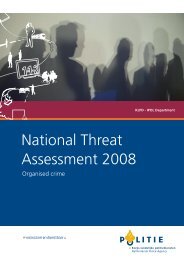Assessing the Effectiveness of Organized Crime Control Strategies ...
Assessing the Effectiveness of Organized Crime Control Strategies ...
Assessing the Effectiveness of Organized Crime Control Strategies ...
Create successful ePaper yourself
Turn your PDF publications into a flip-book with our unique Google optimized e-Paper software.
perspective, as this aggressive law enforcement effort yielded unprecedented totals in terms <strong>of</strong><br />
seizures, indictments, arrests, convictions, and asset forfeitures. In 1986 alone, nearly one-half<br />
billion dollars in assets were seized. Cocaine seizures increased from 2,000 kilos in 1981 to<br />
36,000 in 1987. DEA arrests doubled and, by 1987, over 40 percent <strong>of</strong> all new prison inmates<br />
went in for drug <strong>of</strong>fences (Kenney and Finckenauer, 1995:194).<br />
While <strong>the</strong>se apparent successes were being achieved, <strong>the</strong> price for <strong>the</strong> target drugs was dropping<br />
and purity increased significantly. The domestic cultivation <strong>of</strong> marijuana rose dramatically and<br />
<strong>the</strong> supply <strong>of</strong> cocaine more than tripled from 1980 to 1988, from 40 to 140 metric tons per year<br />
(Kenney and Finckenauer, 1995:194). The “wholesale” price <strong>of</strong> cocaine in Miami dropped by 90<br />
percent from 1980 to 1986, an indication <strong>of</strong> a major glut in <strong>the</strong> market (Shannon, 1988:367).<br />
During <strong>the</strong> same period, cocaine-related hospital emergencies rose more than six-fold.<br />
Examining <strong>the</strong> evidence as a whole, <strong>the</strong> United States’ Office <strong>of</strong> Technology Assessment<br />
(Kenney and Finckenauer, 1995:194) pronounced <strong>the</strong> aggressive supply-reduction effort a<br />
failure, noting that, “Despite a doubling <strong>of</strong> Federal expenditures on interdiction over <strong>the</strong> past five<br />
years, <strong>the</strong> quantity <strong>of</strong> drugs smuggled into <strong>the</strong> United States is greater than ever.”<br />
The picture, however, is not totally negative. The retail price <strong>of</strong> cocaine on <strong>the</strong> streets <strong>of</strong><br />
American cities did increase from 1989 to 1990, indicating that enforcement efforts may have<br />
started to pay <strong>of</strong>f in <strong>the</strong> 1990s (Lyman and Potter, 1991:261).<br />
Returning to <strong>the</strong> 1980s, many American cities became battlegrounds for gangs fighting over<br />
markets and <strong>the</strong> new drug cartels came to exert considerable influence in several Latin American<br />
and Caribbean countries. The drug war and its consequences strained America’s relations with<br />
several Latin American countries (Nadelmann, 1988). Moreover, <strong>the</strong> excesses <strong>of</strong> <strong>the</strong> zero<br />
tolerance approach were illustrated by <strong>the</strong> occasional large-scale asset forfeitures <strong>of</strong> vessels and<br />
vehicles carrying miniscule amounts <strong>of</strong> drugs (Kenney and Finckenauer, 1995:196). In one case,<br />
for example, a 52-foot vessel was impounded because <strong>of</strong> cocaine dust found on a rolled up dollar<br />
bill. In ano<strong>the</strong>r case, an $80 million research vessel was seized after .01 ounce <strong>of</strong> marijuana was<br />
found in a crewman’s shaving kit. Such examples led some observers to comment that <strong>the</strong> war<br />
on drugs had significantly diminished <strong>the</strong> civil liberties <strong>of</strong> Americans.<br />
Ano<strong>the</strong>r illustration <strong>of</strong> <strong>the</strong> limitations <strong>of</strong> interdiction strategies was seen in <strong>the</strong> early 1980s,<br />
following <strong>the</strong> establishment <strong>of</strong> <strong>the</strong> South Florida Task Force in 1982. This broad, anti-drug<br />
effort reduced trafficking to Florida; however, <strong>the</strong> increased law enforcement pressure resulted in<br />
<strong>the</strong> displacement <strong>of</strong> drug smuggling to Gulf <strong>of</strong> Mexico and Eastern ports <strong>of</strong> entry. The successes<br />
achieved by <strong>the</strong> Florida multi-agency approach <strong>the</strong>reby “exacerbated an already serious<br />
nationwide drug problem” (President’s Commission on <strong>Organized</strong> <strong>Crime</strong>, 1986:289).<br />
Never<strong>the</strong>less, this approach served as <strong>the</strong> basis for <strong>the</strong> 12 regional <strong>Organized</strong> <strong>Crime</strong> Drug<br />
Enforcement Task Forces established in 1983.<br />
While <strong>the</strong> President’s Commission was supportive <strong>of</strong> <strong>the</strong> supply-reduction strategy and <strong>the</strong><br />
targeting <strong>of</strong> high-level OC groups involved in drug trafficking, it expressed agreement with <strong>the</strong><br />
concern that supply-reduction alone might be counterproductive in that it might streng<strong>the</strong>n more<br />
powerful criminal organizations. The Commission noted that such an approach might<br />
“exacerbate <strong>the</strong> nation’s OC problem by enriching organized crime groups, eliminating <strong>the</strong>ir<br />
Research and Statistics Division / Department <strong>of</strong> Justice Canada | 49








